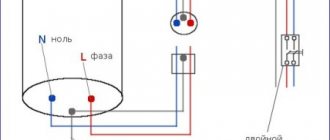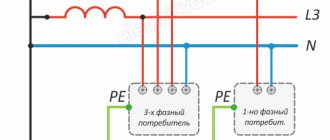Purpose
The main task of grounding elements is to protect the electrician and any other person from the supply of current to the workplace. In addition, the device performs the functions of removing induced voltage.
Simply turning off a transformer or electric power plant while an electrician is working cannot guarantee one hundred percent protection against electric shock. The fact is that during operation a high or induced voltage may arise that cannot be foreseen. To protect against these factors, portable grounding is used, which does not allow electric currents to enter the area where people work.
The main task of portable grounding is to reduce randomly occurring currents to zero. If such a current appears, a short circuit will occur in the designated area. If the protection is triggered, the voltage source will be turned off automatically.
Essential elements
As a rule, this is a simple design consisting of three parts: it includes a contact, conductive, and insulating part. The systems themselves are divided into rod, rodless, and rod with metal links. During testing, the integrity of the rod handles and the reliability of the connection with the clamps are checked. Voltage tests are intended for operational devices only, as well as measuring ones. Portable grounding rods do not pass voltage tests.
The conductive part is usually made in the form of a flexible wire. The contact part is a clamp equipped with clamps and fasteners. The insulation is usually flexible and may have a supporting cord.
Portable grounding is used only in cases where there are no stationary grounding blades (they deserve special attention and a separate article).
For portable grounding, there are GOST standards that devices must comply with.
Device
There are two main options for using PP. The first option is intended for use in switchgears, and the second - on overhead power lines. Grounding can be made in single-phase or three-phase design.
The PZ can be made in three design variations: rod, rod with a metal link (ZPL-10) and rodless (ZPP-15).
Portable grounding type ZLP-10
The design of the product consists of the following elements:
- flexible conductor (copper or aluminum);
- fastening clips;
- tips (clamps);
- dielectric rod.
The rodless design of the PZ is usually used for use in complete switchgears.
Example of a rodless PZ design
To simultaneously short-circuit three phases through a single grounding conductor, a three-phase grounding conductor is used.
Single-phase version of portable grounding is intended for separate connection of phases to the grounding loop. Used on power lines with a voltage level of more than 110 kV. This is due to the significant distance from the grounding bus to the phase wires and the phase-to-phase span.
The flexible conductor may be coated with transparent insulation. It can be made of aluminum or copper wires. Using clamps, the PZ is attached to live parts and to the ground loop. The device of phase clamps can be made in the form of clamps and copper tips. The clamps are tightened using an insulating rod, with the help of which the minimum permissible distance to live parts is achieved.
What to do if the microphone is buzzing
What are they made from?
The main materials for creating portable grounding are copper and aluminum. Aluminum is quite rare, as it cannot always withstand high loads, and is more expensive. Most often, the conductive part is made of copper wires. The wire itself is not always equipped with insulation. The insulated conductor has a transparent shell. During testing, this point is checked, since the insulation may prevent detection of a wire break.
In order for the device to be secured to an electrical appliance, there are special clamps at the end of each wire. Clamps of this design allow you to securely fix the insulation.
In order to be able to secure the grounding using clamps, you need an insulating rod and a special eyelet on the clamp. It is possible to use another design with a lamb, but it is much less common.
Wires should never be connected using twists. To ensure reliable contact between them and the clamps, the connection is made using crimping, welding or bolted connections.
Attention! Do not solder wires intended for grounding.
The importance of application timing
Any items have their own service life, for example, for portable grounding they are no more than 8 years, according to GOST requirements. The need to comply with the deadlines for testing portable groundings is explained quite simply. If you do not adhere to them, the risk of danger during work will increase. The equipment must be in good condition, which must be checked regularly.
If portable structures malfunction, they are replaced. Compliance with operational deadlines helps to avoid many problems that may be associated with dilapidated structures. Replacement is carried out if, as a result of tests, it is discovered that more than 5% of the wires are broken, or the wires are melted, or the strength of the contacts is compromised.
Standard requirements
Checking portable groundings should be carried out regularly, but the timing is regulated by regulations. The standards insist on a testing frequency of at least once every six months. In addition, GOST requires external inspection of portable grounding systems at least two more times in the same time period. Research is carried out more often if grounding is used for medical devices, devices used to restore health, or conduct special therapy.
The same requirements apply to other devices that affect the functioning of the human body or are used for a long time. This rule also applies to sources of increased danger. If you plan to transfer the grounding to another device and connect it to a new circuit, the portable grounding tests will need to be carried out again. When moving the grounding, the terms are calculated anew. The only exception is the general service life.
Once the device is connected to the new circuit, quality data will be collected and a thorough visual inspection will be required to help identify mechanical damage.
When using a system with a solidly grounded neutral, not only it, but also the phase-zero circuit is checked.
Requirements for portable grounding
The main requirement for portable groundings is their thermal and dynamic resistance to short circuit current. The clamps with which conductors are secured to live parts must be such that they cannot be torn off by dynamic forces. In addition, the clamps must provide very reliable contact. Otherwise, if there is a short circuit, they will overheat and burn.
When short-circuit current flows, the short-circuiting conductors become very hot. Therefore, they must be sufficiently thermally stable to remain intact during the tripping time of the short-circuit protection relay. It must be borne in mind that copper melts at a temperature of 1083 ° C. The thermal stability of conductors is important, because when the conductors are heated and broken, the operating voltage of the electrical installation may appear at their ends. The minimum cross-section for reasons of mechanical strength is accepted: for electrical installations with voltages above 1000 V - 25 mm2 and for electrical installations with voltages below 1000 V - 16 mm2. Conductors smaller than these cross-sections cannot be used. For electrical installations with a voltage of 6 - 10 kV with significant short circuit currents, portable grounding conductors are of a very large cross-section (120 - 185 mm2), heavy and difficult to use. In such cases, it is allowed to use two or more portable grounding connections, installing them in parallel, one directly next to the other.
Sections of grounding conductors in electrical installations above 1000 V
| Grounding conductor cross-section, mm2 | Maximum permissible short-circuit current, kA with duration of main relay protection, s | ||
| 0,5 | 1,0 | 3,0 | |
| 25 | 10 | 7 | 4 |
| 50 | 20 | 14 | 8 |
| 70 | 25 | 18 | 10 |
| 90 | 35 | 25 | 15 |
| 2x50 | 40 | 28 | 16 |
| 2x95 | 70 | 50 | 30 |
The cross-section of portable grounding conductors is calculated using a simplified formula:
S = (Iset √tph) / 272,
where Ist is the steady-state short-circuit current, A,
tf — fictitious time, sec.
For practical purposes, the value of tf can be taken equal to the time delay of the main relay protection of the connection of the electrical installation, the switch of which must disconnect the short circuit at the portable grounding point. In order not to make portable grounding connections of different cross-sections for switchgear of the same voltage, the longest one is usually taken as the design time delay.
In networks with a grounded neutral, the cross-section of the conductors is calculated based on the single-phase short circuit current, while in a system with an isolated neutral, it is sufficient to ensure thermal stability during a two-phase short circuit. It is not allowed to use insulated wire for grounding conductors, because insulation does not allow timely detection of damage to the conductor cores, which reduces its design cross-section and can lead to flashover by short circuit current.
Portable grounding
The design of the clamps for connecting conductors must ensure the possibility of their reliable and durable fastening to live parts using a special rod for installing grounding. The short-circuiting conductors are connected directly to the terminals without adapter lugs. This requirement is explained by the fact that the tips may contain unsatisfactory contacts that are difficult to detect, but which may burn out when a short circuit current flows. The connection of the three-phase grounding short-circuiting conductors to each other and to the grounding conductor is carried out firmly and reliably by crimping or welding. A bolted connection can also be made, but in addition to the bolts, the connection must be soldered with hard solder. Connection by soldering alone is not allowed, since the heating of the groundings during the flow of current can reach hundreds of degrees, at which point the solder will melt and the connection will be broken.
Ways to maintain equipment in good condition
Not all companies can afford to maintain a special laboratory and hire a permanent specialist on staff.
It is much more profitable to use the services of electrical laboratories that operate under a contract and have special equipment for testing. Specialists will not only carry out tests and a thorough check, but will also keep a special logbook in which they will make notes about the tests, their results and planned dates.
Contacting a specialized company will allow you to avoid problems, strictly meet deadlines, keep portable insulation in good condition, without incurring high costs. The electrical laboratory can issue protocols on the basis of which permits are obtained for the use of portable equipment.
How to install and check
Even if the electrical equipment is completely turned off, this does not guarantee protection against electric shock accidentally accumulated in the system. It is precisely in order to isolate random currents that portable grounding is used. The safety of workers directly depends on whether the grounding system is installed correctly. GOST establishes certain requirements regarding the installation of grounding. There are certain criteria regarding the installation sites themselves, so during testing the installation sites are checked. Installation must comply with the following requirements:
before starting work, it is necessary to check whether the wires and switchgear are live;- the wires must have a cross-section of at least 25 mm if the installation is for 1000 V and above, and at least 16 mm if the installation is designed for a lower voltage;
- If the equipment needs to be moved, the ground cable may be disconnected.
During testing, the cross-sectional diameter of the wire and the reliability of the clamps are checked. The contacts must be connected in strict sequence: first, connect the grounding tap, then the parts through which the current will flow. Removal of the device occurs in the reverse order. If work is carried out in places with a high fire hazard, additional protective equipment is required in the form of rubber shoes and gloves .
How to properly remove portable grounding
Removal of grounding should be done in the reverse order using a rod and dielectric gloves. That is, first remove it from live parts and then disconnect it from grounding devices. If the nature of work in electrical circuits requires removal of grounding (for example, when checking insulation with meggers), temporary removal of groundings that interfere with the work is allowed. In this case, the place of work must be prepared in full compliance with the above requirements. And only for the duration of the work can those groundings be removed, in the presence of which the work cannot be completed.
In electrical installations with voltages above 110 kV, grounding should be removed using rods. Even if at the installation site it is possible to perform the operation without a rod. In electrical installations with voltages of 110 kV and below, it is permissible to use only dielectric gloves. Moreover, only in cases where to remove the grounding it is not necessary to climb onto the disconnector structures. Turning on and off grounding knives, applying and removing portable groundings must be taken into account according to the operational scheme, in the operational log and in the work order.
Re-grounding of the pen-conductor/neutral wire at the entrance to the house/building
How to store it correctly
The storage conditions for portable grounding systems are also strictly regulated. This requires a specially equipped place, dry and ventilated. All kits are pre-numbered, and during testing the inspector can inspect the storage location.
All operations with portable grounding must be reflected in a special order; a mnemonic or operational diagram must be drawn up. Each ground must have its own number, which will be marked on the diagram. This will make it easy to determine where the system is located.










